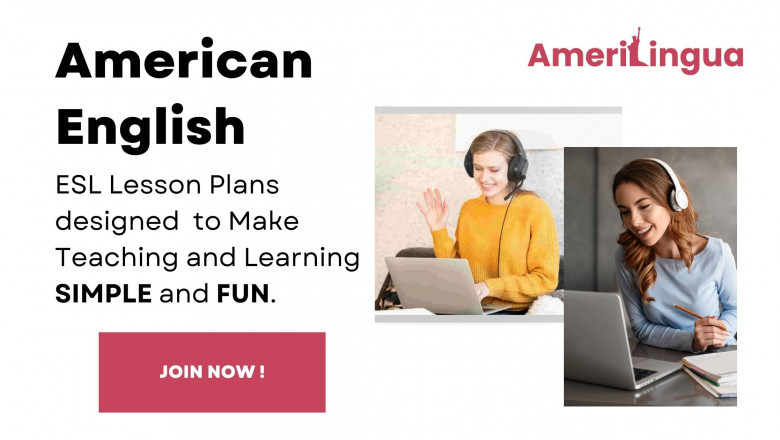views
Creating the right lesson plan for an ESL (English as a Second Language) classroom can feel like juggling fire while riding a unicycle—especially if your learners range from shy beginners to chatty advanced speakers. The challenge isn’t just about covering grammar and vocabulary. It’s about doing so in a way that feels alive, relevant, and inspiring to a wide range of learners. That’s where high-quality ESL lesson plans come into play.
If you've ever asked yourself, “How do I keep my students engaged and learning effectively?”—you’re not alone. Whether you're a new teacher or a seasoned educator looking to refresh your approach, this guide will walk you through the essentials of building ESL lesson plans that actually work. Let’s explore what makes a lesson plan not just functional, but impactful.
Why Thoughtful ESL Lesson Plans Matter
Too many classrooms rely on last-minute improvisation or repetitive drill-based exercises that suck the life out of language learning. The truth is, well-structured ESL lesson plans are the backbone of successful teaching. They help you:
-
Stay organized
-
Meet curriculum standards
-
Adapt to student needs
-
Encourage participation
-
Track progress efficiently
Without a clear plan, you risk losing control of your classroom—and your students’ interest.
Understanding the Needs of Your Learners
No two ESL students are the same. Some are visual learners. Others thrive with audio or kinesthetic activities. Some want business English; others need conversational skills for daily life.
Before writing your lesson plan, take time to assess:
-
Language level: Are they beginners or advanced?
-
Motivation: Are they learning for work, school, travel, or citizenship?
-
Learning style: Do they prefer group discussions, writing exercises, or games?
-
Cultural background: What topics might resonate—or fall flat?
The more you understand your students, the more targeted and effective your lessons will be.
Building Blocks of an Effective ESL Lesson Plan
A great lesson plan is like a good story: it has a beginning, a middle, and an end. Let’s break it down.
1. Warm-Up (5–10 minutes)
Start with something light and engaging to activate students’ English brain. This could be:
-
A quick question of the day
-
A fun vocabulary review game
-
Sharing a short opinion about a picture or news headline
The goal is to build confidence and set a relaxed tone for the class.
2. Introduction of New Material (15–20 minutes)
Present new grammar, vocabulary, or conversation topics. Keep explanations brief and visual where possible.
-
Use images, realia (objects), or videos
-
Encourage students to guess meanings from context
-
Limit teacher talk time—make it interactive
3. Guided Practice (20 minutes)
Now that they’ve seen the new material, let them try it with support. This can include:
-
Dialogues in pairs
-
Fill-in-the-blank exercises
-
Structured roleplays
This stage is critical for building confidence before jumping into more independent tasks.
4. Free Practice or Production (20 minutes)
Let students use the language more creatively. Options include:
-
Group discussions
-
Opinion-sharing on a topic
-
Mini-presentations
Encourage risk-taking. Mistakes here are part of the learning process.
5. Wrap-Up and Review (5–10 minutes)
End with a short review of the day’s lesson. This could be a quiz, a reflection question, or asking students what they learned today.
Tips for Keeping ESL Lesson Plans Fresh and Dynamic
Use Real-Life Materials
Authentic content—like menus, song lyrics, YouTube clips, or news articles—makes your lessons more relatable and fun.
Incorporate Tech
Tools like Quizlet, Kahoot, or Google Slides can bring a lesson to life and cater to tech-savvy students.
Rotate Activity Types
Too much repetition kills motivation. Mix things up with group work, games, writing assignments, and listening tasks.
Be Flexible
Sometimes your students will struggle with a grammar point, or a roleplay will spark a fascinating discussion. Be willing to adjust your plan to suit the moment.
Where to Find Quality ESL Lesson Plans
You don’t have to reinvent the wheel every time. Plenty of resources offer ESL lesson plans tailored for various skill levels, teaching contexts, and themes.
When selecting a lesson plan resource, look for:
-
Customizability: Can you tweak the content to suit your class?
-
Clear structure: Is it easy to follow?
-
Real-world relevance: Does it prepare students for real interactions?
-
Built-in activities: Are there games, discussions, and tasks ready to go?
One of the most reliable sources for professionally designed ESL lessons is Amerilingua, which offers materials that strike the right balance between structure and engagement.
Common Pitfalls to Avoid
-
Overloading the lesson: Too much new content can overwhelm learners.
-
Neglecting speaking practice: Conversation is king in language acquisition.
-
Not checking comprehension: Always circle back to see if students truly understood.
-
Being too rigid: Leave space for spontaneous learning moments.
Final Thoughts
Designing ESL lesson plans isn’t just a box to check—it’s a powerful tool for building confidence, fluency, and connection in your classroom. The most effective plans are flexible, interactive, and centered around real communication. Whether you’re teaching online or in person, to kids or adults, your lesson plans should reflect the needs and interests of the people sitting in front of you.
Start small. Stay curious. And don’t be afraid to revise and experiment until you find what works for you and your learners.
And remember, if you ever need a solid, ready-made lesson plan to save time or spark inspiration, you can always turn to trusted resources like ESL lesson plans that do the heavy lifting while letting your personality and teaching style shine.














Comments
0 comment